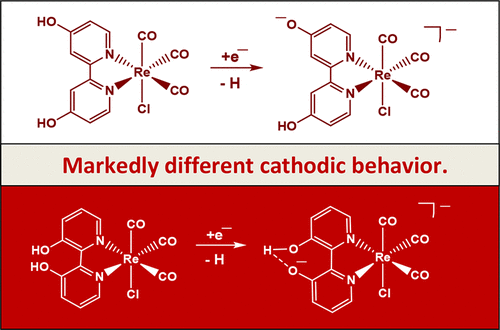当前位置:
X-MOL 学术
›
Inorg. Chem.
›
论文详情
Our official English website, www.x-mol.net, welcomes your
feedback! (Note: you will need to create a separate account there.)
Strong Impact of Intramolecular Hydrogen Bonding on the Cathodic Path of [Re(3,3'-dihydroxy-2,2'-bipyridine)(CO)3Cl] and Catalytic Reduction of Carbon Dioxide.
Inorganic Chemistry ( IF 4.3 ) Pub Date : 2020-04-02 , DOI: 10.1021/acs.inorgchem.0c00263 James O Taylor 1 , Gaia Neri 2 , Liam Banerji 2 , Alexander J Cowan 2 , František Hartl 1
Inorganic Chemistry ( IF 4.3 ) Pub Date : 2020-04-02 , DOI: 10.1021/acs.inorgchem.0c00263 James O Taylor 1 , Gaia Neri 2 , Liam Banerji 2 , Alexander J Cowan 2 , František Hartl 1
Affiliation

|
Herein, we present the cathodic paths of the Group-7 metal complex [Re(3,3'-DHBPY)(CO)3Cl] (3,3'-DHBPY = 3,3'-dihydroxy-2,2'-bipyridine) producing a moderately active catalyst of electrochemical reduction of CO2 to CO. The combined techniques of cyclic voltammetry and IR/UV-vis spectroelectrochemistry have revealed significant differences in the chemistry of the electrochemically reduced parent complex compared to the previously published Re/4,4'-DHBPY congener. The initial irreversible cathodic step in weakly coordinating THF is shifted toward much less negative electrode potentials, reflecting facile reductive deprotonation of one hydroxyl group and strong intramolecular hydrogen bonding, O-H···O-. The latter process occurs spontaneously in basic dimethylformamide where Re/4,4'-DHBPY remains stable. The subsequent reduction of singly deprotonated [Re(3,3'-DHBPY-H+)(CO)3Cl]- under ambient conditions occurs at a cathodic potential close to that of the Re/4,4'-DHBPY-H+ derivative. However, for the stabilized 3,3'-DHBPY-H+ ligand, the latter process at the second cathodic wave is more complex and involves an overall transfer of three electrons. Rapid potential step electrolysis induces 1e--reductive cleavage of the second O-H bond, triggering dissociation of the Cl- ligand from [Re(3,3'-DHBPY-2H+)(CO)3Cl]2-. The ultimate product of the second cathodic step in THF was identified as 5-coordinate [Re(3,3'-DHBPY-2H+)(CO)3]3-, the equivalent of classical 2e--reduced [Re(BPY)(CO)3]-. Each reductive deprotonation of the DHBPY ligand results in a redshift of the IR ν(CO) absorption of the tricarbonyl complexes by ca. 10 cm-1, facilitating the product assignment based on comparison with the literature data for corresponding Re/BPY complexes. The Cl- dissociation from [Re(3,3'-DHBPY-2H+)(CO)3Cl]2- was proven in strongly coordinating butyronitrile. The latter dianion is stable at 223 K, converting at 258 K to 6-coordinate [Re(3,3'-DHBPY-2H+)(CO)3(PrCN)]3-. Useful reference data were obtained with substituted parent [Re(3,3'-DHBPY)(CO)3(PrCN)]+ that also smoothly deprotonates by the initial reduction to [Re(3,3'-DHBPY-H+)(CO)3(PrCN)]. The latter complex ultimately converts at the second cathodic wave to [Re(3,3'-DHBPY-2H+)(CO)3(PrCN)]3- via a counterintuitive ETC step generating the 1e- radical of the parent complex, viz., [Re(3,3'-DHBPY)(CO)3(PrCN)]. The same alternative reduction path is also followed by [Re(3,3'-DHBPY-H+)(CO)3Cl]- at the onset of the second cathodic wave, where the ETC step results in the intermediate [Re(3,3'-DHBPY)(CO)3Cl]•- further reducible to [Re(3,3'-DHBPY-2H+)(CO)3]3- as the CO2 catalyst.
中文翻译:

分子内氢键对[Re(3,3'-dihydroxy-2,2'-bipyridine)(CO)3Cl]的阴极路径的强烈影响和二氧化碳的催化还原。
在这里,我们介绍第7组金属配合物[Re(3,3'-DHBPY)(CO)3Cl](3,3'-DHBPY = 3,3'-dihydroxy-2,2'-bipyridine的阴极路径)生产一种将CO2电化学还原为CO的中等活性催化剂。循环伏安法和IR / UV-vis光谱电化学技术相结合,发现电化学还原的母体配合物的化学性质与以前发表的Re / 4,4相比有显着差异-DHBPY同系物。弱配位THF的初始不可逆阴极步骤向负电势低得多的方向移动,反映出一个羟基的易还原还原性质子化和强分子内氢键OH···O-。后一个过程在Re / 4,4'-DHBPY保持稳定的碱性二甲基甲酰胺中自发发生。随后在环境条件下还原单个去质子化的[Re(3,3'-DHBPY-H +)(CO)3Cl]-的阴极电位接近于Re / 4,4'-DHBPY-H +衍生物的阴极电位。但是,对于稳定的3,3'-DHBPY-H +配体,后者在第二个阴极波处的过程更为复杂,涉及三个电子的整体转移。快速电位步进电解诱导第二个OH键进行1e-还原裂解,触发Cl-配体从[Re(3,3'-DHBPY-2H +)(CO)3Cl] 2-上解离。THF中第二个阴极步骤的最终产物被鉴定为5配位[Re(3,3'-DHBPY-2H +)(CO)3] 3-,相当于经典2e还原的[Re(BPY)( CO)3]-。DHBPY配体的每个还原性去质子化导致三羰基配合物的IRν(CO)吸收发生红移。10厘米-1,根据与相应Re / BPY配合物的文献数据进行比较,促进产品分配。从[Re(3,3'-DHBPY-2H +)(CO)3Cl] 2-分离出Cl-在强配位的丁腈中得到证明。后者的二价阴离子在223 K时稳定,在258 K时转换为6坐标[Re(3,3'-DHBPY-2H +)(CO)3(PrCN)] 3-。用取代的母体[Re(3,3'-DHBPY)(CO)3(PrCN)] +获得了有用的参考数据,该母体也通过初始还原为[Re(3,3'-DHBPY-H +)(CO )3(PrCN)]。后者的络合物通过反直觉的ETC步骤最终在第二个阴极波处转换为[Re(3,3'-DHBPY-2H +)(CO)3(PrCN)] 3-,生成母体络合物的1e-自由基。 ,[Re(3,3'-DHBPY)(CO)3(PrCN)]。[Re(3,3'
更新日期:2020-04-24
中文翻译:

分子内氢键对[Re(3,3'-dihydroxy-2,2'-bipyridine)(CO)3Cl]的阴极路径的强烈影响和二氧化碳的催化还原。
在这里,我们介绍第7组金属配合物[Re(3,3'-DHBPY)(CO)3Cl](3,3'-DHBPY = 3,3'-dihydroxy-2,2'-bipyridine的阴极路径)生产一种将CO2电化学还原为CO的中等活性催化剂。循环伏安法和IR / UV-vis光谱电化学技术相结合,发现电化学还原的母体配合物的化学性质与以前发表的Re / 4,4相比有显着差异-DHBPY同系物。弱配位THF的初始不可逆阴极步骤向负电势低得多的方向移动,反映出一个羟基的易还原还原性质子化和强分子内氢键OH···O-。后一个过程在Re / 4,4'-DHBPY保持稳定的碱性二甲基甲酰胺中自发发生。随后在环境条件下还原单个去质子化的[Re(3,3'-DHBPY-H +)(CO)3Cl]-的阴极电位接近于Re / 4,4'-DHBPY-H +衍生物的阴极电位。但是,对于稳定的3,3'-DHBPY-H +配体,后者在第二个阴极波处的过程更为复杂,涉及三个电子的整体转移。快速电位步进电解诱导第二个OH键进行1e-还原裂解,触发Cl-配体从[Re(3,3'-DHBPY-2H +)(CO)3Cl] 2-上解离。THF中第二个阴极步骤的最终产物被鉴定为5配位[Re(3,3'-DHBPY-2H +)(CO)3] 3-,相当于经典2e还原的[Re(BPY)( CO)3]-。DHBPY配体的每个还原性去质子化导致三羰基配合物的IRν(CO)吸收发生红移。10厘米-1,根据与相应Re / BPY配合物的文献数据进行比较,促进产品分配。从[Re(3,3'-DHBPY-2H +)(CO)3Cl] 2-分离出Cl-在强配位的丁腈中得到证明。后者的二价阴离子在223 K时稳定,在258 K时转换为6坐标[Re(3,3'-DHBPY-2H +)(CO)3(PrCN)] 3-。用取代的母体[Re(3,3'-DHBPY)(CO)3(PrCN)] +获得了有用的参考数据,该母体也通过初始还原为[Re(3,3'-DHBPY-H +)(CO )3(PrCN)]。后者的络合物通过反直觉的ETC步骤最终在第二个阴极波处转换为[Re(3,3'-DHBPY-2H +)(CO)3(PrCN)] 3-,生成母体络合物的1e-自由基。 ,[Re(3,3'-DHBPY)(CO)3(PrCN)]。[Re(3,3'











































 京公网安备 11010802027423号
京公网安备 11010802027423号